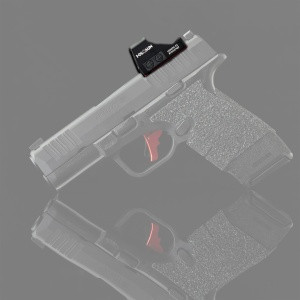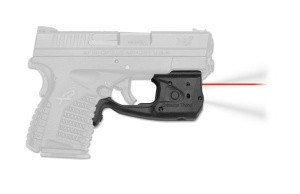What Sight is On My Gun?
- Nov 1st 2024
- By
What’s the difference between a laser and a red dot? They both look like a dot on the target, which leads many folks to mistakenly buy holsters that don’t fit. The terminology can be confusing, with lots of nicknames, acronyms, and technical terms that don’t make sense at first glance.
Here’s a clear, no-nonsense visual breakdown of different sighting systems. You can identify which one you have, and learn which ones are compatible with PHLster holsters. Avoid expensive returns and boxes full of useless holsters with this blog article, part of PHLster’s extensive learning library.
Iron Sights
Iron sights are the traditional default sights on most guns. They typically do not require a special holster.
If you have replaced your stock iron sights with sights that are extra tall (these are called suppressor height sights), you may need a special holster to accommodate the extra height. Some people use suppressor height sights in conjunction with red dot optics, which allows them to use the iron sights as a backup if the optic fails. The extra height makes the iron sights tall enough to be visible through the window of the optic.
PHLster holsters are compatible with most suppressor height sights, but if yours are excessively tall, contact us first to check.
Red Dot Optics

A red dot optic (sometimes called a reflex sight, miniaturized reflex sight, RDO, or just “red dot” for short) mounts on top of your gun’s slide. The dot you see projects onto the optic’s window, so only you can see it. Dots can come in colors other than red. For example, green dots are also popular.
Red dots provide many advantages for shooting, and are quite popular. Many holsters are manufactured to fit red dots. These may say “optic ready” or “optic cut” in the description.
ALL PHLster holsters are compatible with red dots.
Note: because the red dot sits above the gun’s slide, some people choose to put taller iron sights on their gun so they have a backup in case their optic fails. Called “suppressor height sights,” these taller iron sights are tall enough to be visible through the window of the optic. It’s important to make sure your holster is made to accommodate suppressor height sights if you plan on using them along with your red dot. PHLster holsters are compatible with most suppressor height sights, but if yours are excessively tall, please contact us first to check.
Lasers
A laser (also called a visible laser or vis laser) is mounted in front of your gun’s trigger guard. The laser projects through the air from your gun to the target. Everyone can see the laser, not just you. Some lasers are also combined with small lights, though these light/laser combos are usually underpowered and of limited usefulness.
Lasers require specially made holsters, which can be hard to find.
NO PHLster holsters are compatible with lasers.
Safety note: Beware of lasers that require you to activate them with your trigger finger. This design may increase your risk of negligent discharge due to the possibility of the finger slipping into the trigger guard, especially when under stress or working at speed. Related reading.

Grip Lasers

A grip laser (also called a visible or vis laser), is mounted on your gun’s grip. The laser projects through the air from your gun to the target. Everyone can see the laser, not just you.
Unlike a trigger or frame mounted laser, a grip mounted laser is activated by simply squeezing the firearm’s grip (though it does require a firm and consistent grip, which can be challenging for some users in some circumstances).
Some grip lasers do not affect holster fit, and others do. It depends on the design of the grip laser and whether it protrudes into any spaces the holster would normally cover.

